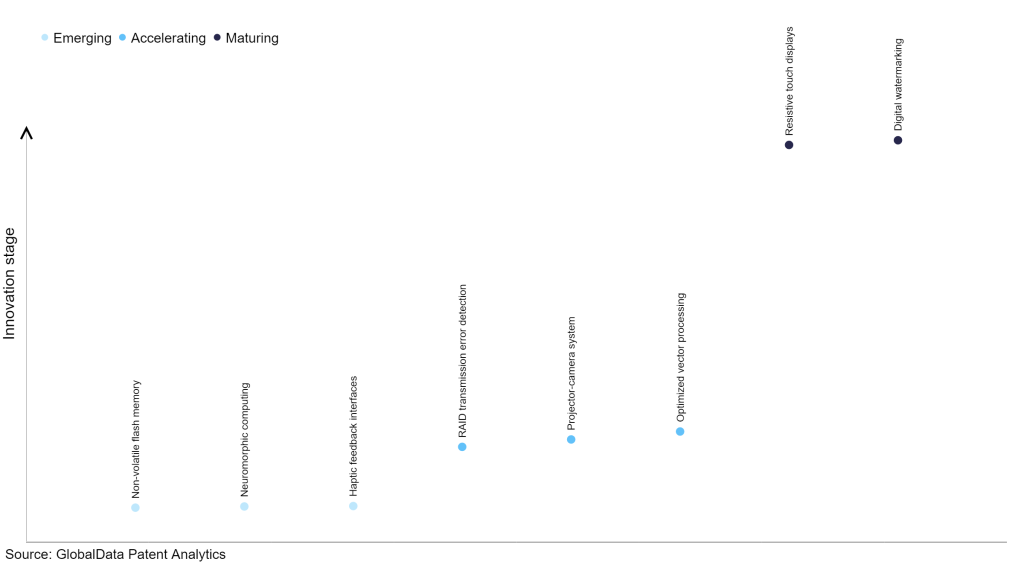The technology industry continues to be a hotbed of patent innovation. Activity is driven by the need for stronger and more comprehensive cybersecurity measures to protect against cyber threats and attacks, secure data transmission, robust authentication mechanisms, and resilient network infrastructure, and growing importance of technologies such as wireless communication technologies, voice over internet protocol (VoIP), geographic information systems (GIS) and emergency alert systems. Emergency communications network may employ data encryption technologies and secure communication protocols to ensure the confidentiality and integrity of sensitive information. In the last three years alone, there have been over 1.5 million patents filed and granted in the technology industry, according to GlobalData’s report on Innovation in technology: emergency communications network. Buy the report here.
However, not all innovations are equal and nor do they follow a constant upward trend. Instead, their evolution takes the form of an S-shaped curve that reflects their typical lifecycle from early emergence to accelerating adoption, before finally stabilizing and reaching maturity.
Identifying where a particular innovation is on this journey, especially those that are in the emerging and accelerating stages, is essential for understanding their current level of adoption and the likely future trajectory and impact they will have.
185+ innovations will shape the technology industry
According to GlobalData’s Technology Foresights, which plots the S-curve for the technology industry using innovation intensity models built on over 1.6 million patents, there are 185+ innovation areas that will shape the future of the industry.
Within the emerging innovation stage, non-volatile flash memory, neuromorphic computing, and haptic feedback interfaces are disruptive technologies that are in the early stages of application and should be tracked closely. RAID transmission error detection, projector-camera system, and optimized vector processing are some of the accelerating innovation areas, where adoption has been steadily increasing. Among maturing innovation areas are resistive touch displays and digital watermarking, which are now well established in the industry.
Innovation S-curve for the technology industry

Emergency communications network is a key innovation area in technology
Emergency communications network refers to a network of interconnected communication channels utilized by government agencies, public safety personnel, and first responders to effectively coordinate and address emergency scenarios. This network encompasses radio systems, telephone systems, computer networks, and various communication tools, facilitating seamless communication and collaboration during critical situations.
GlobalData’s analysis also uncovers the companies at the forefront of each innovation area and assesses the potential reach and impact of their patenting activity across different applications and geographies. According to GlobalData, there are 380+ companies, spanning technology vendors, established technology companies, and up-and-coming start-ups engaged in the development and application of emergency communications network.
Key players in emergency communications network – a disruptive innovation in the technology industry
‘Application diversity’ measures the number of applications identified for each patent. It broadly splits companies into either ‘niche’ or ‘diversified’ innovators.
‘Geographic reach’ refers to the number of countries each patent is registered in. It reflects the breadth of geographic application intended, ranging from ‘global’ to ‘local’.
Patent volumes related to emergency communications network
Source: GlobalData Patent Analytics
Motorola Solutions is one of the leading patent filers in emergency communications network. The company’s patents are aimed at describing the methods and systems for maintaining a required participation level for a plurality of communications devices assigned to task group.
A server is communicatively coupled to the plurality of communication devices assigned to the task group and defines a minimum quantity of communication devices to be assigned an active executor role for the task group.
Communication devices that are assigned the active executor role are locked to the active executor role for the task group when the quantity of communication devices that are currently assigned the active executor role does not exceed the minimum quantity of communication devices to be assigned the active executor role for the task group.
Other prominent filers in the space include Qualcomm and Telefonaktiebolaget LM Ericsson.
By geographic reach, Mutualink leads the pack, followed by Uber Technologies and Unified Messaging Systems. In terms of application diversity, Qualcomm holds the top position, followed by Telefonaktiebolaget LM Ericsson and Samsung Group.
Emergency communications network ensure effective coordination and response during emergency situations by providing reliable and interconnected communication channels. They also enable rapid information sharing, timely decision-making, and efficient deployment of resources, ultimately saving lives and minimizing the impact of emergencies.
To further understand the key themes and technologies disrupting the technology industry, access GlobalData’s latest thematic research report on Technology.
Data Insights
From

The gold standard of business intelligence.
Blending expert knowledge with cutting-edge technology, GlobalData’s unrivalled proprietary data will enable you to decode what’s happening in your market. You can make better informed decisions and gain a future-proof advantage over your competitors.







